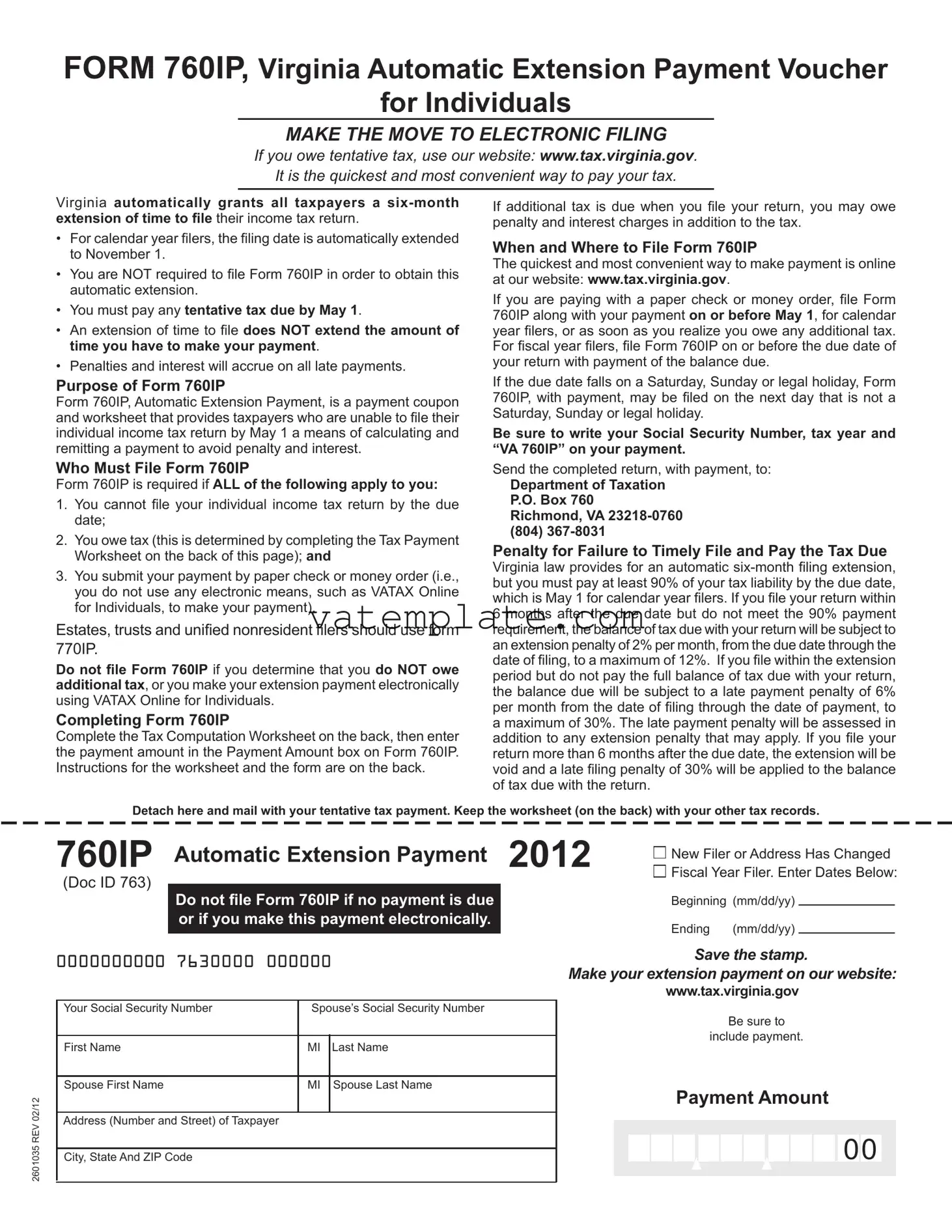Virginia automatically grants all taxpayers a six-month extension of time to ile their income tax return.
•For calendar year ilers, the iling date is automatically extended to November 1.
•You are NOT required to ile Form 760IP in order to obtain this automatic extension.
•You must pay any tentative tax due by May 1.
•An extension of time to ile does NOT extend the amount of time you have to make your payment.
•Penalties and interest will accrue on all late payments.
Purpose of Form 760IP
Form 760IP, Automatic Extension Payment, is a payment coupon and worksheet that provides taxpayers who are unable to ile their individual income tax return by May 1 a means of calculating and remitting a payment to avoid penalty and interest.
Who Must File Form 760IP
Form 760IP is required if ALL of the following apply to you:
1.You cannot ile your individual income tax return by the due date;
2.You owe tax (this is determined by completing the Tax Payment Worksheet on the back of this page); and
3.You submit your payment by paper check or money order (i.e., you do not use any electronic means, such as VATAX Online for Individuals, to make your payment).
Estates, trusts and uniied nonresident ilers should use form 770IP.
Do not ile Form 760IP if you determine that you do NOT owe additional tax, or you make your extension payment electronically using VATAX Online for Individuals.
Completing Form 760IP
Complete the Tax Computation Worksheet on the back, then enter the payment amount in the Payment Amount box on Form 760IP. Instructions for the worksheet and the form are on the back.
If additional tax is due when you ile your return, you may owe penalty and interest charges in addition to the tax.
When and Where to File Form 760IP
The quickest and most convenient way to make payment is online at our website: www.tax.virginia.gov.
If you are paying with a paper check or money order, ile Form 760IP along with your payment on or before May 1, for calendar year ilers, or as soon as you realize you owe any additional tax. For iscal year ilers, ile Form 760IP on or before the due date of your return with payment of the balance due.
If the due date falls on a Saturday, Sunday or legal holiday, Form 760IP, with payment, may be iled on the next day that is not a Saturday, Sunday or legal holiday.
Be sure to write your Social Security Number, tax year and “VA 760IP” on your payment.
Send the completed return, with payment, to:
Department of Taxation
P.O. Box 760
Richmond, VA 23218-0760 (804) 367-8031
Penalty for Failure to Timely File and Pay the Tax Due
Virginia law provides for an automatic six-month iling extension, but you must pay at least 90% of your tax liability by the due date, which is May 1 for calendar year ilers. If you ile your return within 6 months after the due date but do not meet the 90% payment requirement, the balance of tax due with your return will be subject to an extension penalty of 2% per month, from the due date through the date of iling, to a maximum of 12%. If you ile within the extension period but do not pay the full balance of tax due with your return, the balance due will be subject to a late payment penalty of 6% per month from the date of iling through the date of payment, to a maximum of 30%. The late payment penalty will be assessed in addition to any extension penalty that may apply. If you ile your return more than 6 months after the due date, the extension will be void and a late iling penalty of 30% will be applied to the balance of tax due with the return.


 New Filer or Address Has Changed
New Filer or Address Has Changed 
 Fiscal Year Filer. Enter Dates Below:
Fiscal Year Filer. Enter Dates Below: